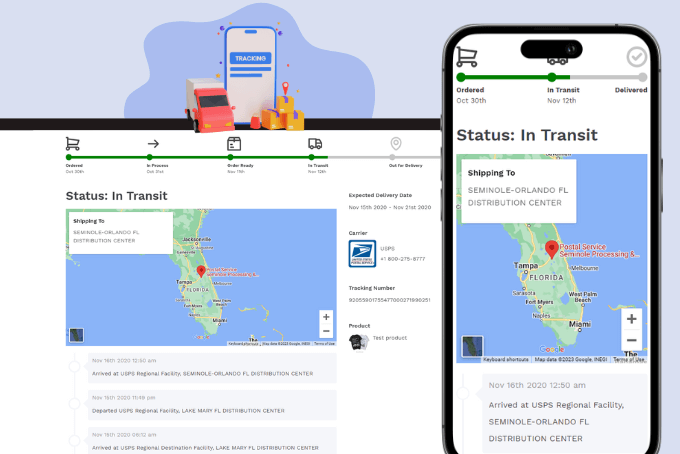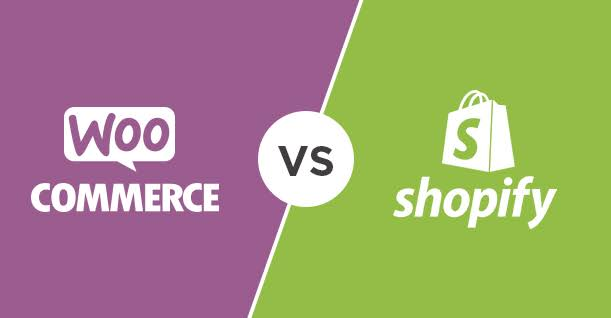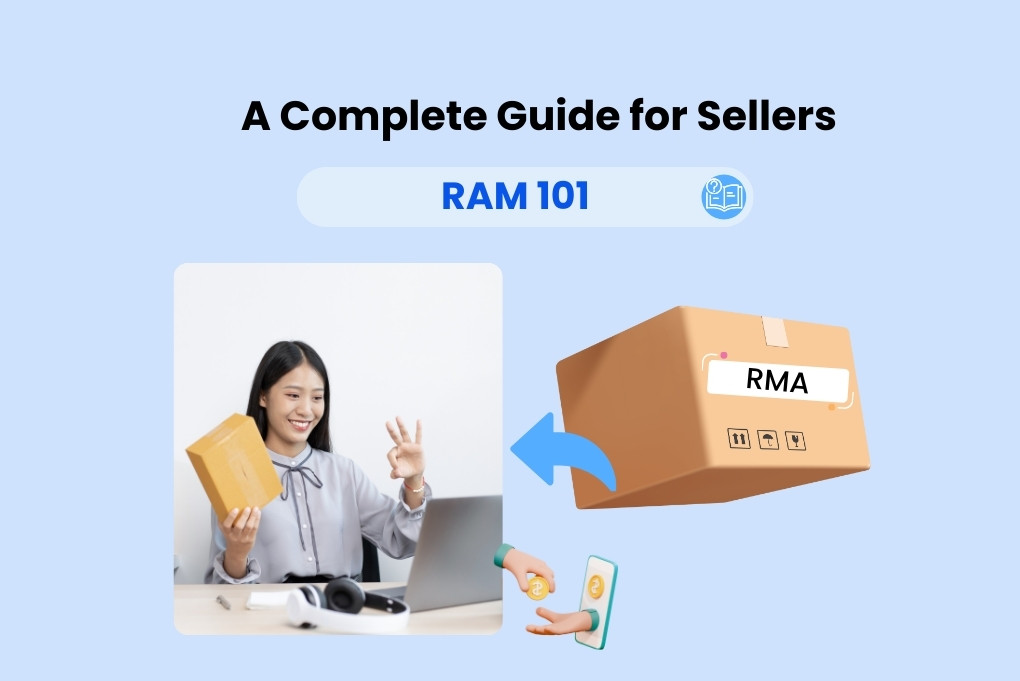
Source: Shopify
Introduction
There are numerous challenges faced by online sellers as their business grows. One of them is to satisfy their unsatisfied customers no matter how much effort putting into their products. In the event that they are unattainable, it is essential for them to determine the best return policies in order to minimize losses while maintaining relationships.
These requests can consume a significant amount of time, energy, and money without a proper system in place for handling returns, including a clear return and refund policy. Hours can be spent on customer support emails, and shipping costs for replacement products can increase, particularly after the holidays.
A robust system is necessary for an online business to succeed, but it also needs the support of its online shoppers. Online sellers can control returns and lessen the possibility of having unhappy customers if they have a clear return policy.
Online sales involve exchanges, refunds, and returns. But you may attract new customers to buy from you and convert dreaded return requests into repeat business with a well-crafted return policy and a system to handle requests.
This article will explain what a returns policy is, why it’s important to have a customer-centric return policy, what to be included, and how to write a successful Shopify return policy with tips and examples.
What is a Shopify Return Policy?
You can create guidelines and procedures for your customers’ ability to return or exchange items they have bought from your online store by creating a returns policy. An effective return process for unwanted or damaged products is facilitated by your Shopify returns policy.
You are free to design an eCommerce return and refund policy that fits your business model, guarantees happy customers and lowers expenses and hassles for the company as long as you follow the return rules.
A return policy should include key elements such as return guidelines and requirements, justifications for returns, exclusions, kinds of returns, and return window. Online sellers can easily increase the likelihood of their customers making additional purchases and becoming lifelong customers by clearly communicating to them what they can return.
Since customers can only assess the ordered items after they open the package, eCommerce stores have higher return rates than brick-and-mortar stores, despite the fact that technological advancements are continually improving the online shopping experience.
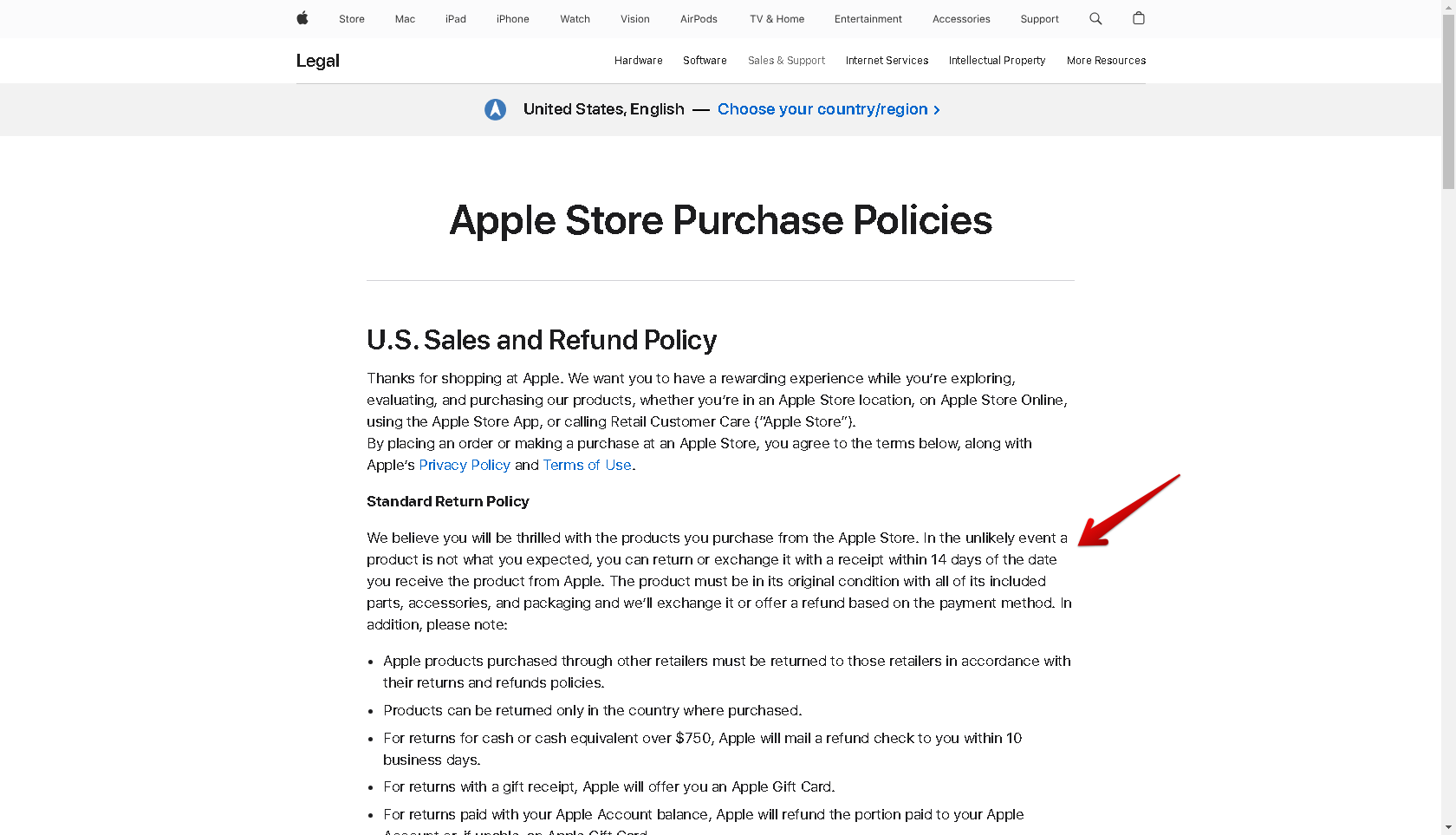
Source: Apple
From Apple’s strict 14-day return policy, to IKEA‘s generous 365-day turnaround, just about every major retailer offers return and refund policies to their customers—and your business should, too.
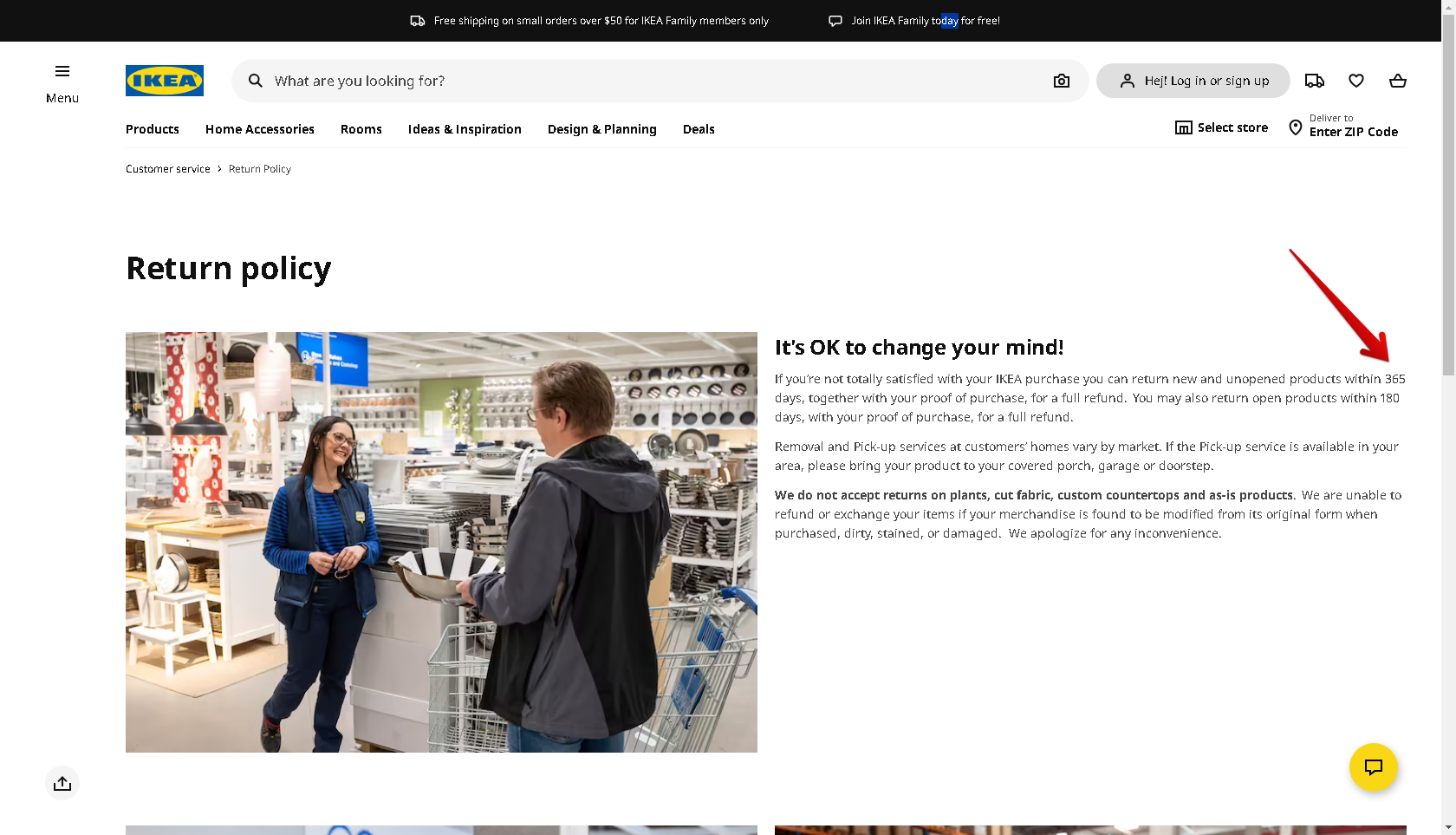
Source: IKEA
Understanding the Shopify pricing plans is essential for store owners managing costs including those related to returns and refunds. Different plans may offer different levels of support or features related to handling returns so make sure you choose the most suitable one for your online store.
The Importance of Creating a Return Policy?
Every store owner needs to understand the importance of setting up a return policy that works for their company and striking a balance between maintaining a high level of revenue and customer satisfaction despite unavoidable returns before learning how to create a return policy on Shopify.
An unclear or insufficient return policy for eCommerce can result in a backlog of customer complaints. Consumer frustration and anger result in unfavorable online word-of-mouth. All of these have the long-term negative effect of reducing the amount of money that both new and existing customers spend with the company.
Retain Customers with Trust
eCommerce businesses that have a clear return policy and a simple, user-friendly returns process that lives up to their expectations are trusted by both new and returning customers.
Potential customers are typically wary of making a purchase from a new brand, so if return and refund policies aren’t handled promptly, they’ll just find another retailer. Customers who have already shopped with you in the past and are dissatisfied with the return process or the overly complicated store policies are unlikely to come back.
People should be able to easily locate your return policy on your website, in the footer, and important sections like product pages or other web pages where customers could look up return information, in order to build customer trust and improve customer satisfaction.
With these free Shopify themes, you can customize how return policies are displayed and interacted with on a Shopify store. Selecting a theme that not only looks good but also effectively communicates your return policies.
Increase Revenues
Having an understandable and transparent return policy on Shopify shows your concern for your customers and your readiness to manage the procedure with professionalism and responsibility. Customers are more likely to make purchases from your store if they are aware that you offer simple returns in the event that one or more items don’t live up to their expectations.
The long-term advantages of a positive customer experience, which lead to higher retention rates and steady revenue growth, may outweigh the short-term profit loss on a purchase return. Find out what your customers expect from you and emphasize the benefits like free returns or pre-printed return shipping labels in order to enhance your return process.
Establish Clear Guidelines
A thorough return policy keeps customers informed about the procedure and establish clear expectations right away. If they are aware of the things that can be returned, the exceptions to the standard returns policy, or the estimated processing time for returns, your customers will be better equipped to make decisions about their purchases.
A proactive approach to problem solving is the implementation of clear guidelines and store policies. They assist you in preventing customers’ confusion and dissatisfaction and in creating a satisfying return process for items.
Use these Shopify development services to directly tailor how your return policies are optimized in Shopify stores beyond the default options provided by Shopify.
Prevent Fraudulent Returns
Your eCommerce store can deter fraudulent attempts by online shoppers to return items and receive a refund by implementing a thorough return policy. Assist your team in rejecting fraudulent returns, identifying questionable online shopping activity, and processing only authentic returns.
Establish explicit terms under which you accept returns, outline the necessary paperwork, and outline any fees you may impose in order to deter abuse and misuse of your return policy. Shopify apps for return management typically have features that can identify suspicious return requests automatically, and they work wonders for streamlining the entire process.
What Elements to Include in a Shopify Return Policy?
Reasons for returns
In order to control return ratios and prevent fraud, you should encourage appropriate use of your return and refund policy in addition to establishing a generous return policy that boosts customer satisfaction and brand loyalty.
You need to understand why your customers are returning products and figure out the main reason in order to figure out how to add a return policy on Shopify that helps you hit a balance between keeping customers happy and maintaining profitability.
Here’s a list of reasons for returns that eCommerce stores generally accept:
- The product is damaged or nonfunctional;
- The original packaging is damaged;
- The product is missing parts or accessories;
- The product’s performance or quality is below expectations;
- The product doesn’t match the description on the website;
- The customer bought or received the wrong item;
- The delivery date was delayed;
- The purchase was unauthorized or fraudulent;
- The merchant sent the package to the incorrect shipping address.
You may optimize returns management, modify the eCommerce return policy, and find areas for business operations improvement by tracking and evaluating the reasons behind returns using your Shopify admin or returns portal.
What kind of items are not returnable?
You should make it clear why a return is denied and that you check each returned item to determine whether it is eligible for a refund in order to avoid confusion and arguments.
The following are some instances of items that are not returnable:
- Final sale items;
- Customized or personalized items;
- Perishable products;
- Limited-edition items;
- The item that is returned damaged due to the customer’s action;
- Items with visible signs of use;
- Items without proof of purchase;
- Items without tags, manufacturer’s tags, or original packaging.
What are the return instructions & requirements?
Describe the procedures that customers need to follow in order to start and finish a return request. Provide the necessary paperwork, any specific terms under which you accept an item for return, and the deadlines for customer returns.
Here are some examples of requirements you might include:
- The customer must provide a valid purchase receipt;
- The item must be returned with the original packaging;
- The item must have the original tags;
- The customer must provide an authorization number;
- The customer must specify the return shipping address;
- The customer must send photos that show the product’s condition;
What is the time frame for the customer to return an item?
The period of time during which customers are returning your merchandise to you is known as the return window.
Customers want to know how long they have to return a product before heading to the checkout and finishing their purchase. Customers should be informed of this time frame both before and after making a purchase. And it should be mentioned in the store’s return policy and in the email that confirms their order.
To promote sales and guarantee a smooth return process, give customers a precise and fair return period. eCommerce stores usually apply standard timeframes of 14 to 30 days from the delivery date. Certain items at certain stores have extended shelf lives, especially during the holidays.
What type of refund will be provided?
Customers usually expect to get a full refund when they request a return. This is especially true for people who just want their money back because they weren’t happy with the product they received. In this instance, the original payment method like a debit or credit card that was used to receive the refund.
Other customers, though, might be open to substitutes like gift cards, store credit, or exchanges. With the help of these options, you can expedite the return process and preserve customer satisfaction while reducing the financial impact of returns on profits. Make sure that your return policy mentions store credit, gift cards, or exchanges so that customers know about these practical options.
You can enable a self-service returns portal that lets customers select their preferred refund method to streamline and expedite the returns process. One of the best Shopify apps for managing returns can be used to add the self-service portal functionality to your store.

Source: Shopify
Use a return policy template or a policy generator if you’re just getting started and don’t have much experience writing return policies. These resources can be useful beginning points, but you should modify the policy as needed, make sure it complies with legal requirements, and match your business objectives and customer expectations.
Best Tips for More Profitable Returns
It is inevitable that a strong return policy and system will be expensive. Even though an app can reduce the amount of time you spend on customer support but shipping fees of returning a product and restocking can still negatively impact your bottom line.
Nonetheless, there are a few strategies you can employ to reduce your losses and still provide customers with an excellent return policy.
1. Turn returns into exchanges
When comparing returns and exchanges, the distinction becomes most apparent when considering profitability. Usually, your business loses money on customer acquisition and return shipping costs when a customer returns a product for a refund. In addition, you will have to reimburse the client for any earnings from the initial order.
The loss is frequently less severe when there is an exchange. Offering a replacement product in lieu of a full refund can help your company’s cash flow stay positive if your products have strong margins.
One popular strategy to promote exchanges over returns is to limit the free return shipping to instances where the customer decides to exchange the item.
2. Offer store credit
Offer store credit as an additional means of minimizing losses from a full refund.
When given the choice between the three options mentioned above, people who haven’t completely given up on your brand might find the option to receive a store credit more enticing. Store credit can encourage customers to spend the same amount—or even more—in a subsequent transaction, even though the benefits are not as instantaneous as those of an exchange.
Customers are more likely to return and make another purchase if they are satisfied, so encouraging them to give your brand another go with a new order on store credit can also help increase lifetime value.
3. Upsell or cross-sell on exchange requests
Upselling or cross-selling in response to exchange requests is one best practice for e-commerce returns. Exchanges can be narrowly profitable depending on the product and its margins, even though they are typically more profitable than returns. It could be a good idea to consider upselling or cross-selling on exchanges if they are still very expensive.
You have the chance to present new items that they didn’t buy the first time around that go well with what they’re exchanging for when a customer returns to your website to use their store credit.
You can use a number of apps to show customers related products at the checkout if you own a Shopify store.
Don’t forget to modify your shipping policy for refunds. Consider letting customers add more items to their cart in order to meet the free shipping threshold in situations where they are willing to pay shipping costs. Knowing the reasons behind the exchange makes it easier to upsell and allows you to offer a suited suggestion for a more expensive item that fulfills needs that weren’t met on the first order.
For instance, you can suggest a lighter model that may cost more up front but fixes the problem a customer had with their initial order if they are returning a digital camera because it was too heavy.
Converting more returns into exchanges makes sense when you consider each return as a fresh chance to upsell or cross-sell and raise order value.
Shopify Return Policy Template
Shopify return policies can be set up in a variety of ways, but having a template makes things simpler for online retailers. This is a basic template that Shopify store owners can use to create their own policies. This template, which can be easily modified to fit any business or industry, can be found below. All they have to do is change the bolded text in accordance with their own policy, using the lists as a guide.
By having a formal return policy in place, you can handle every request the same way and resist the urge to handle on a case-by-case basis, which is frequently less efficient and more costly.
Once you have logged into your account, follow these steps:
- Go to the ‘Settings‘ tab on the left-hand side of the dashboard.
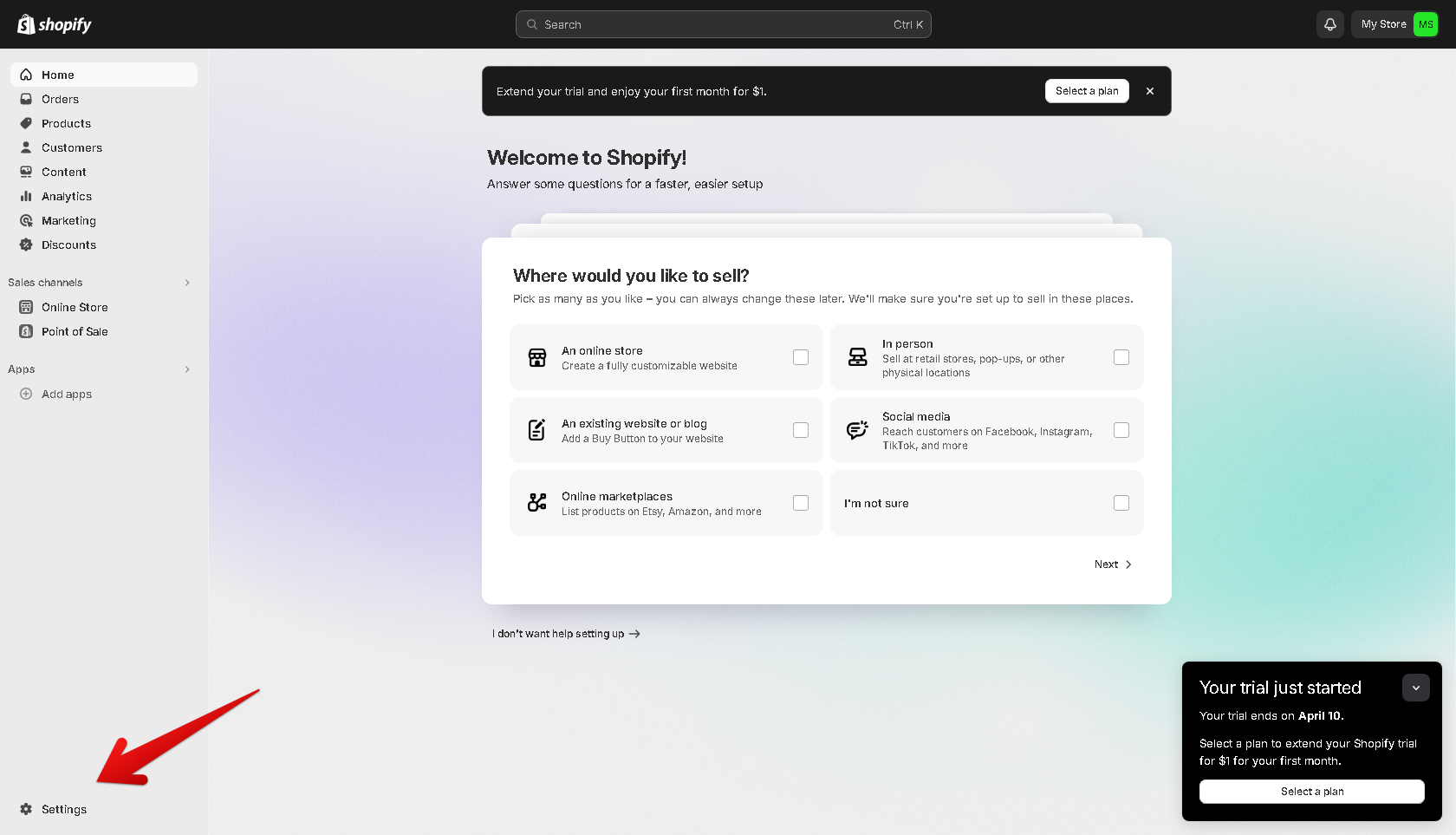
- From there, click on the ‘Policies‘ section. You’ll find a list of pre-made policy templates, including a refund policy.
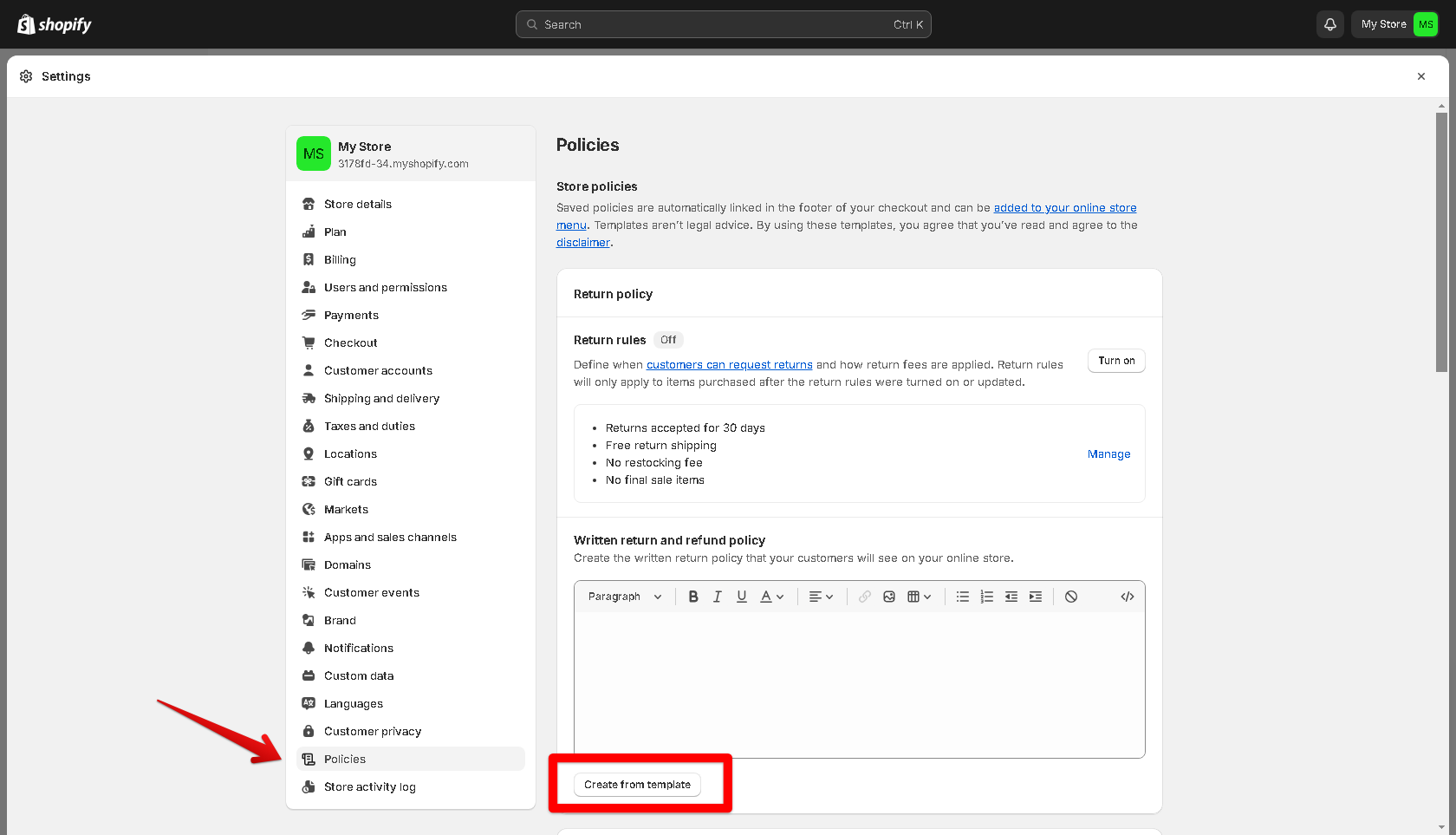
A premade Shopify refund policy template is a quick and easy way to add a refund policy to your Shopify store. Here’s how to do that:
- On the policies page, find the ‘Refund‘ section.
- Click on “Create from template” in the Refund section.
- A new template will be created by Shopify, which is customizable to suit your store.
“If you’re looking to return or exchange your order for whatever reason, we’re here to help! We offer free returns within 30 days of purchase. You can return your product for store credit, a different product, or a refund to the original payment method.”
Please note the following exceptions to our return and exchange policy:
Below are some examples of common exceptions:
- Discounted items are final and cannot be returned or exchanged
- Returned items must have tags still on and be returned in original packaging
- Returned items must have no visible signs of wear or use
- To initiate a return or exchange, please complete the following steps:
Your steps should be laid out clearly, linking to relevant pages, such as your online portal.
- Login to our online return portal using your email address and order ID
- Choose the products you wish to return or exchange from your order
- Print your prepaid shipping label that you will receive by email
- Send all items back to us using the label provided
Additional Information:
The following are add-ons with more information that you may want to include.
- How long it takes to receive your refund, replacement product, or store credit
- Any shipping fees the customer will need to pay
- Any return restocking fees the customer will need to pay
- How you handle lost or damaged returns
- Contact information for your business if the customer has more questions
Top 3 Shopify Return Policy Examples
1. Kirrin Finch
First example we have a Shopify brand namely Kirrin Finch where they make it so easy to navigate and simple to understand the return policy requirements.
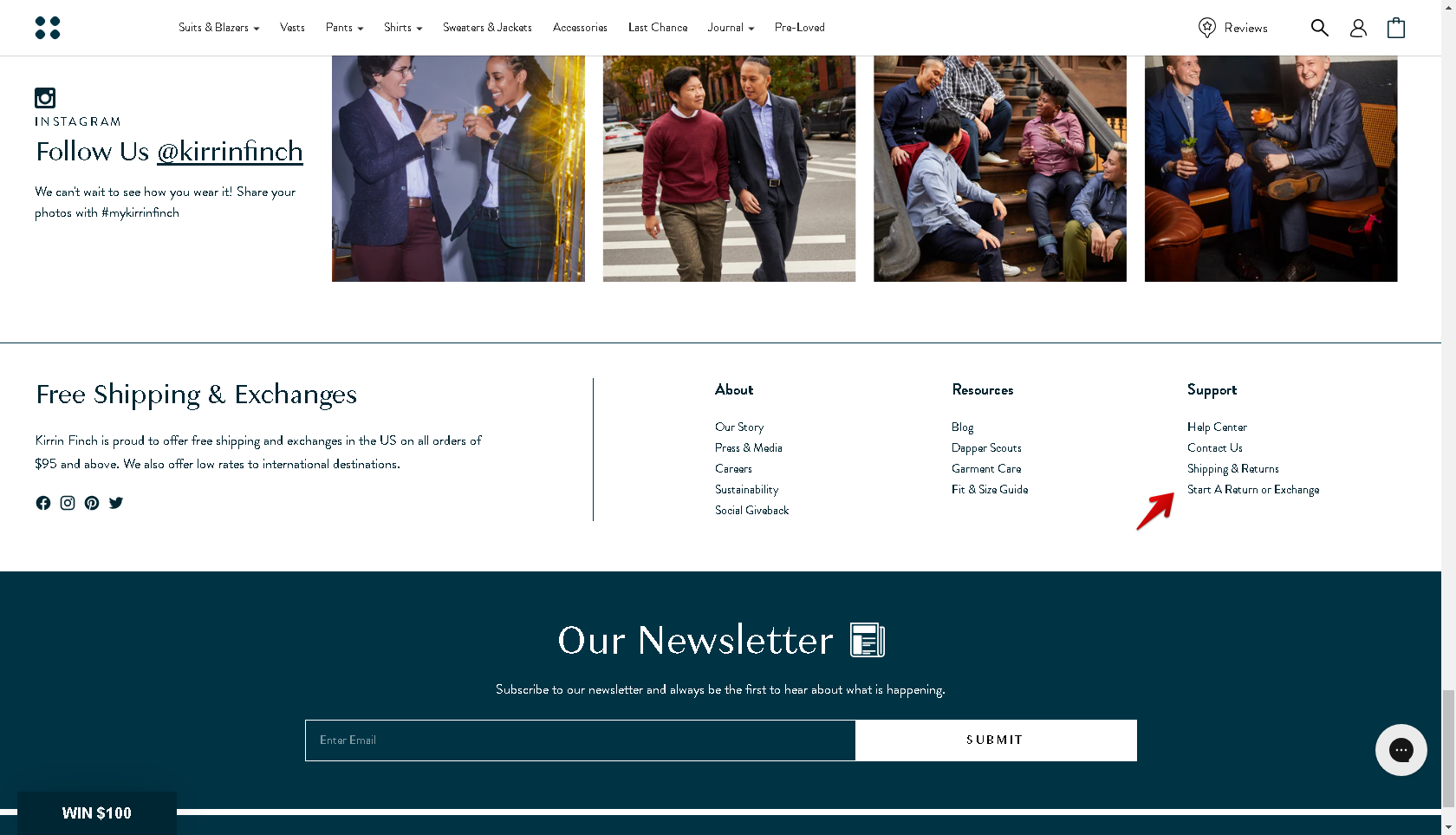
This online store’s return policy clearly states the time frame within which customers can return a product for a refund. They even used bold fonts to easy to find.
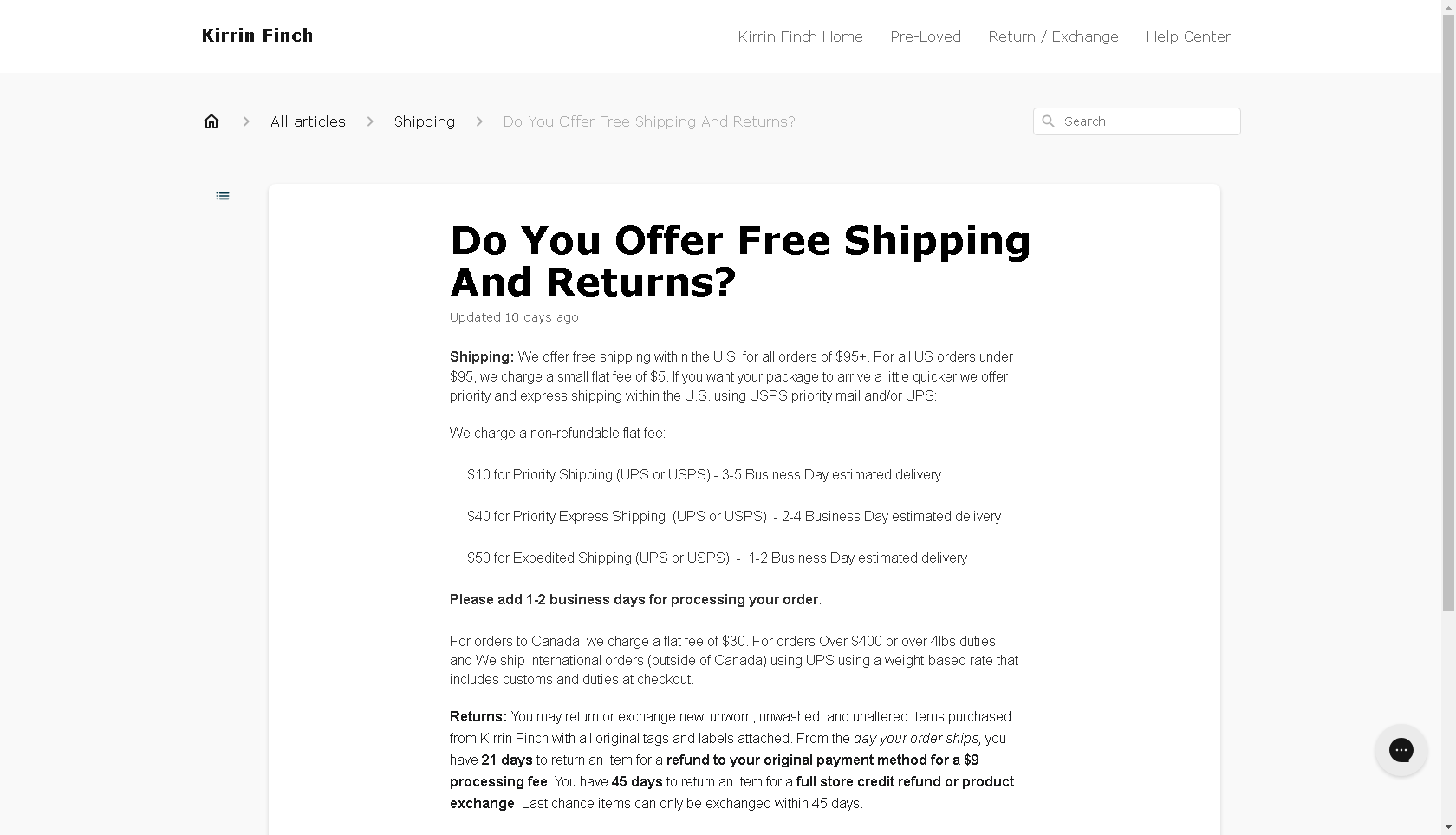
If you read carefully, there’s this part where the brand is recommending shoppers to get an exchange at the same time: “We’d love for you to exchange your items, however as an international customer, it’s faster if you place an order for your preferred items, and return your original items for a refund.” Then it can really give shoppers to have a thought about it.
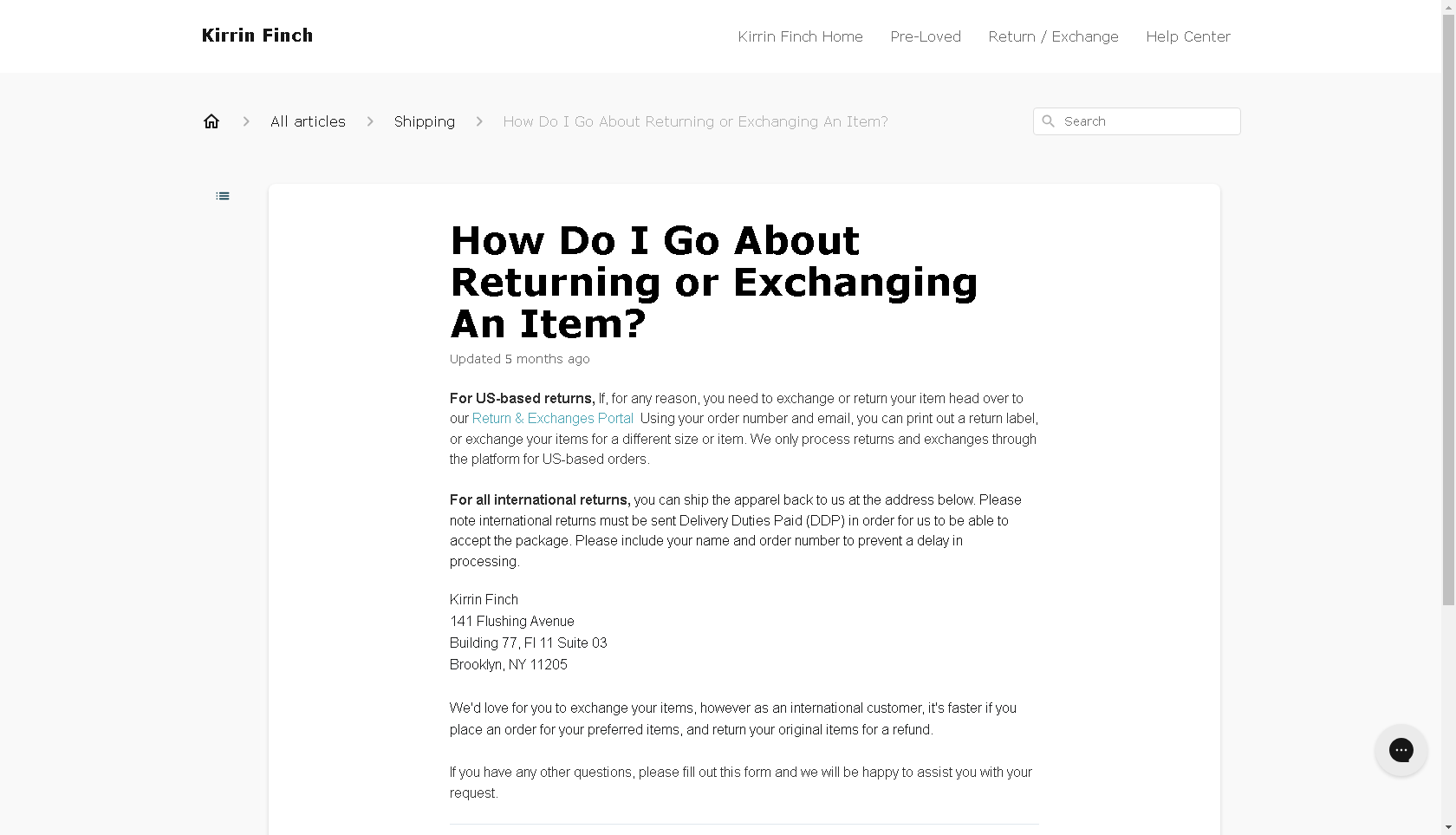
Here they even built a separate return portal for the shoppers to track and process their returns.

2. Rothy’s

This Shopify store offers 2 ways for online buyers to choose from either by visiting a nearby store or processing returns via their return portal.
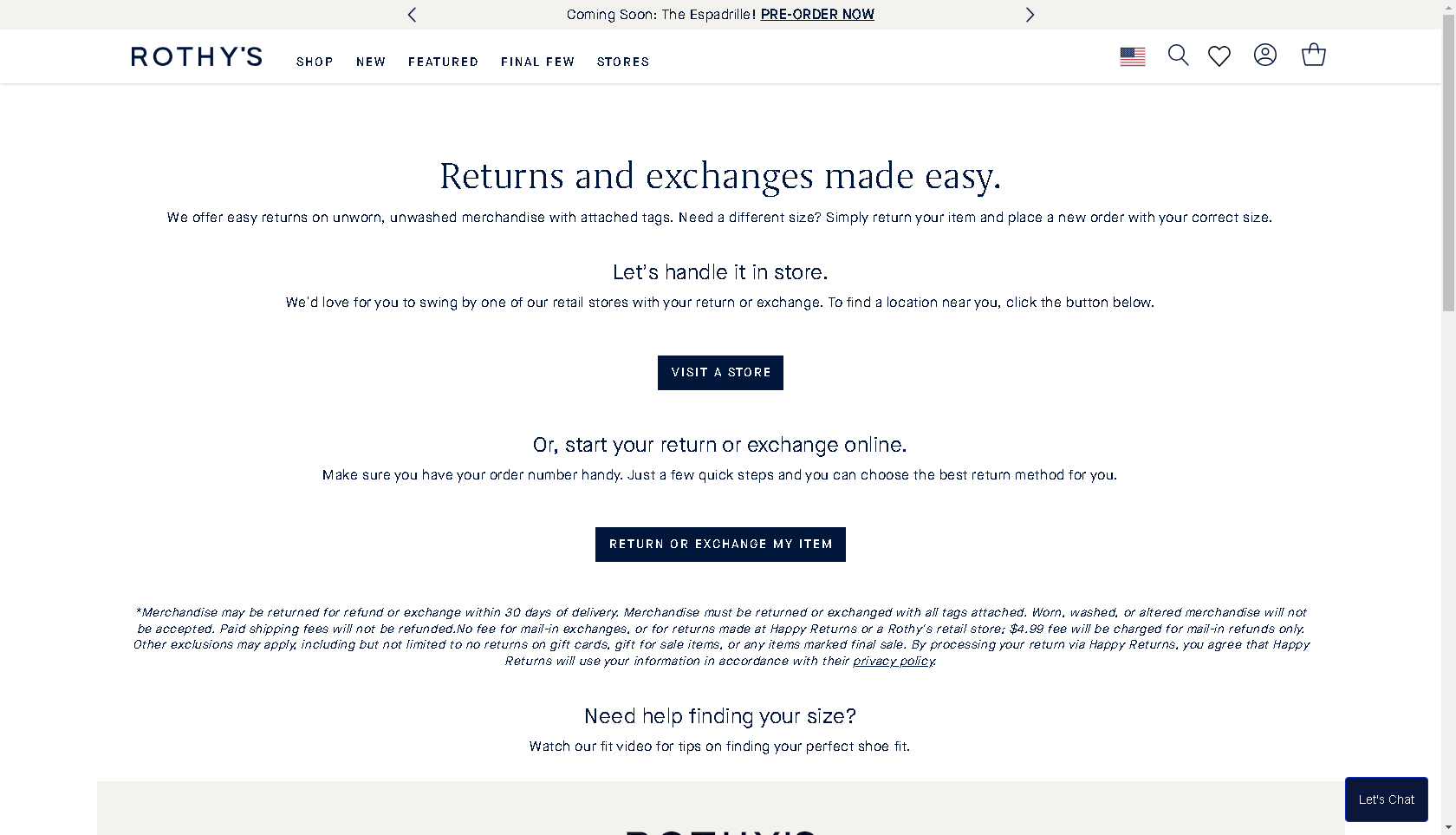
Their returns and exchanges page even got customized and looking so pretty.

3. Bruvi
Look at their “60 Day No Questions Asked Returns” statement! This can really build customer trust and customer confidence because the refund process just sounds much easier.
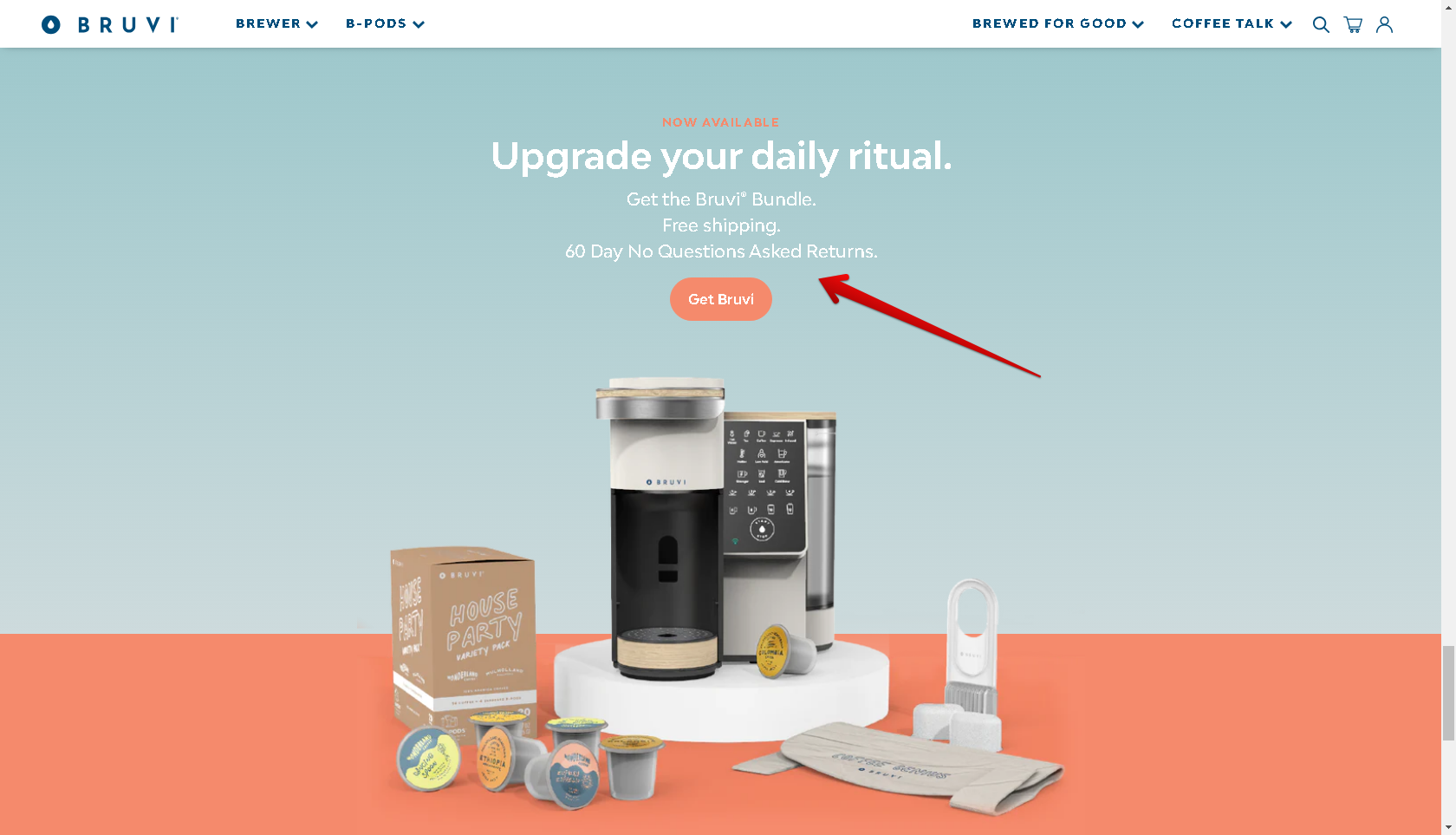
The keyword “returns & exchange policy” can be seen easily on this online store design.
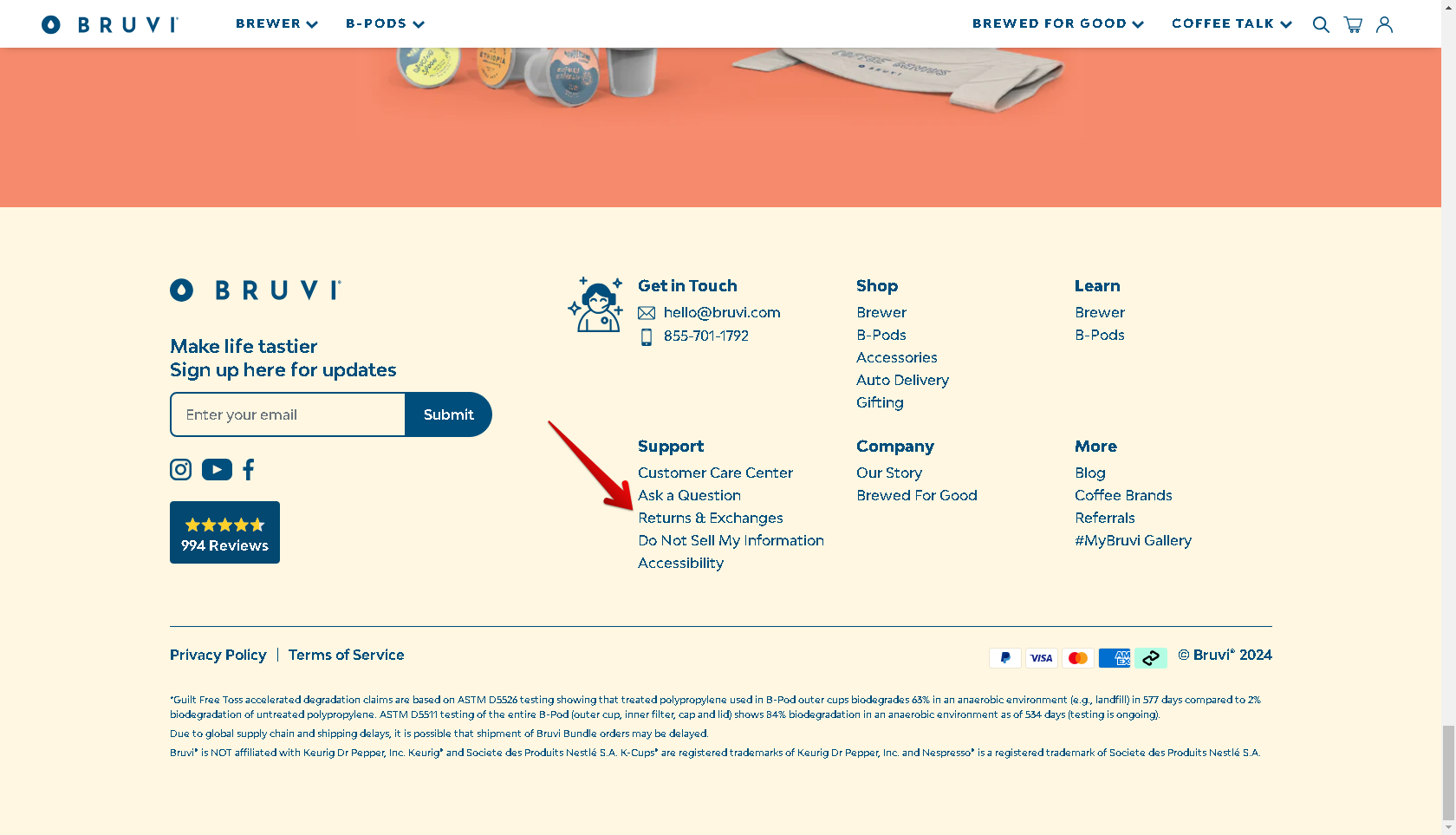
Their return and refund policy stands out as the top customer friendly return policy when they stated: “We want you to love your Bruvi brewer. That’s why we offer 60 Day No Questions Asked Returns.” This can really attract the potential buyers.
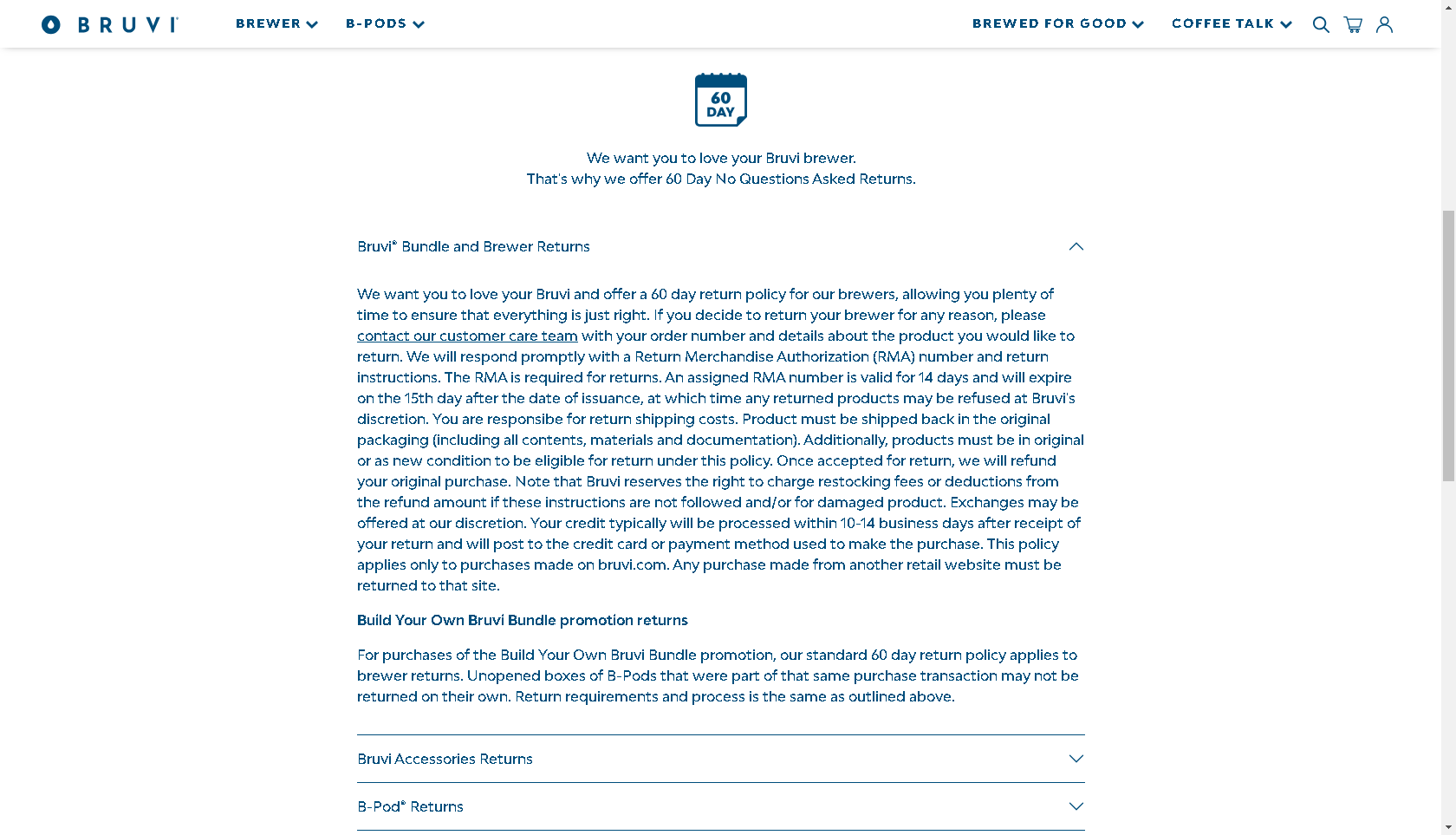
The shipping costs were also clearly stated whom will be responsible for it.
Conclusion
You’re likely to run into a few unhappy consumers as your business expands, no matter how hard you work on your product and customer experience.
The way online businesses choose to handle these unhappy customers has a big impact on how long their brand will last. Businesses that can handle return requests with a relatively painless shipping plan have a higher chance of keeping their customers, getting them to make additional purchases or, even better, telling their friends about them.
Online retailers who want to give their customers the option of returns and exchanges must have a proper return policy. They can enhance customer service and manage risks to their profitability when they are successful in encouraging customers to return.
